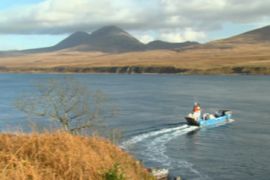Scotland tests unique green project
Plans emerge to test the world’s first underwater sea turbines.

A revolutionary idea is stirring among the peaceful islands off the west coast of Scotland. It is a plan to produce green, renewable energy by harnessing the power at the bottom of the sea.
The Sound of Islay is a strait 8km long and one-kilometre wide. As I crossed it on the car ferry to Jura, I was almost directly above the spot, 60m below on the sea bed, where engineers will place 10 giant turbines driven by the tide.
It runs at a phenomenal 3m/s here. If they get it right, this will be the first project of its kind in the world.
Blades 10m long would turn at 10 times a minute at peak flow – a bit like an underwater wind farm.
Keep reading
list of 4 itemsTurtles swimming to extinction in Malaysia as male hatchlings feel heat
Could shipping containers be the answer to Ghana’s housing crisis?
Thousands protest against over-tourism in Spain’s Canary Islands
Each turbine would produce one megawatt of power, together it is enough to provide electricity for Islay’s 3,500 people.
Green dream
Scotland has 25 per cent of all the tidal-energy potential in Europe – along with wind and wave power. Some dream of a country that will one day use only green energy.
One of them is Andrew Macdonald, from the Islay Energy Trust. He believes that Scotland is blessed with untapped natural energy.
“It’s a question of combining all the resources available and feeding the power into the electricity grid,” he says. “Much of this work is a testing ground. We’re getting better and more efficient as we go along. But it proves we’re not just talking about climate change in Scotland. We’re doing something about it.”
If they can show that the Islay project is a success, then there are bigger ones to come. For instance, further north in the Pentland Firth the tides – and wind – are even stronger.
The Islay project will cost more than $80m and has yet to prove cost effective.
The engineers will have to tread carefully. Fishermen are worried about their gear becoming snarled in the turbines and the impact on wildlife including dolphins, whales and diving birds.
Fisherman Dougal Ferguson told me that he was 60 per cent for the project and 40 per cent against.
“If nets or other debris did become entangled in the turbines, then it strikes me there would be a big maintenance job. They would have to haul the blades out of the water to work on them,” he said. “I can see the environmental benefits of this project, but they will have to think very carefully about all the consequences.”
He and the rest of the small fishing fleet will have to be reassured and there are studies being carried out to assess the environmental impact.
Intoxicating future
Engineers are confident that fish and seals will be able to avoid the slowly turning giant blades, but submerged debris floating down the sound could be a problem.
The Scottish parliament will have the final say on planning permission. It is keen on exploiting Scotland’s natural power, and the energy company Scottish Power hopes the Islay project will encourage others to join the green revolution.
Alan Mortimer, head of renewables, believes the Islay project can serve as an international demonstration. As well as the environmental benefits, it would also provide work locally and help develop green skills.
The turbines could be operational in 2011, contributing to Scotland’s target of generating up to 2GW (2,000MW) of electricity from tidal and wave power by 2020.
Islay’s world famous whisky makers are already on board. They need guaranteed electricity to power their distilleries – the Caol Ila Distillery alone produces 81,000 litres a week.
Billy Stitchell is the fourth generation of his family to work in the business and he says the company is keen to reduce its carbon footprint. The giant turbines in the sound, which runs past the distillery windows, would help them to achieve that.
The tidal power created by the pull of the Moon and the Sun on the sea has always existed.
It may be expensive to capture, but many believe if the opportunity isn’t taken now, the eventual cost to the earth could be much higher.